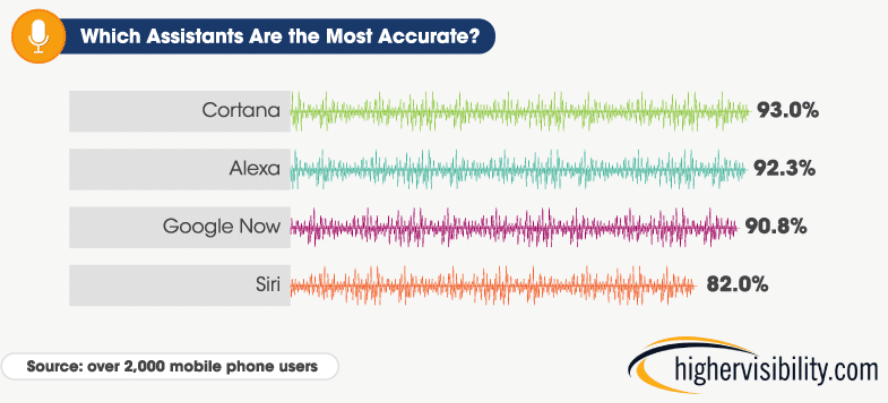These days, the key to success, whether you run a nonprofit organization, an online business, or an eCommerce shop, is anticipating people’s needs and identifying the micro-moments your target audience is most likely to experience. After all, 76% of consumers expect companies to understand their needs and expectations.
Adding to that, those same 76% of people claim that leaving one brand for another in search of a better experience is easier than ever.
Digital Assistant Strategies Your Team Needs To Know
Knowing what people need and when, and then delivering it right away after finding out, is how marketers are going to push themselves ahead of the competition and grow. Luckily, with the advancement of digital assistants, providing personalized experiences for each individual that interacts with your brand is more attainable than ever, if you know what you’re doing.
Today we’re going to take a brief look at what the future of digital assistants look like and how marketers can be ready to utilize the power digital assistants hold in generating interest, leads, and sales.
The Future of Digital Assistants
A digital assistant is a computer program that leverages artificial intelligence to not only understand input such as text, voice, and data, but also answer questions and complete tasks for an individual.
When you think about a digital assistant, the first thing that comes to mind might be your home device spouting off the weather or your phone asking if you want directions or to call a business. But the truth is, digital assistants are able to engage in meaningful conversations and even predict your next move.
The more input a user provides a digital assistant, the more personalized, concise, and accurate the results will be.
And since studies show that people are increasingly willing to share personal information with brands in exchange for personalized results, digital assistants seem to hold the most power, especially in the marketing world.
So how can you and your marketing team proactively prepare for the next big marketing revolution: digital assistants?
By following our 4 step checklist.
The Rise of Digital Assistants (and Your Marketing Plan)
1. Create Strong Buyer Personas
The first thing you need to do before preparing to engage with customers via digital assistants is to create solid buyer personas. You need to know exactly who your target audience is and what they need from you.
Buyer personas help you understand customers and supporters so you can tailor your content, overall messaging, and products/services to meet the specific needs of different groups based on their demographics, behavior, and concerns.
There are many ways to collect the information needed to create proper buyer personas, including:
- Analyze current data and identify how leads, customers, and supporters find your brand and consume your content
- Use online forms to capture relevant information about those engaging with your brand and showing interest (e.g., company size)
- Talk to your sales team and customer support representatives to find out what trends they notice while interacting with current and potential customers
- Gather feedback from people interacting with your brand across multiple channels using online surveys, phone calls, and structured interviews
Once you’ve gathered enough information about your target audience to create a solid buyer persona, you’ll need to organize it in an easy to understand way that your entire team can reference at any time.
We recommend starting by using a tool like Avatar Maker to create a visual representation of your buyer persona(s).
Next, take the data you’ve collected about each buyer persona and enter it, along with the avatars you’ve created, into one convenient location, such as a well-structured dropbox or google drive folder.
Now you have a simple layout of each buyer persona for your brand. As new personas are discovered, simply create a new avatar and document that can be used to boost sales and market your brand.
2. Utilize Existing Data
Digital assistant marketing may be brand new to you and your organization, and that’s okay. You don’t have to have a way to cater to consumers and supporters via digital assistants right this minute if you want to succeed.
But what you do need to do right now is work on providing optimal user experiences for your target audience by assisting them in similar ways a digital assistant would.
For example, you might want to begin:
- Crafting ads that are more relevant to your buyer personas
- Arming your customer support reps with the answers to all questions and procedures to follow when they don’t have an answer
- Enabling chatbots on your website to answer questions 24/7, guide people through the sales funnel, or encourage people to sign up
- Using contact information to segment email marketing campaigns and encourage more brand interaction
Oftentimes organizations collect tons of valuable data about their existing audience and never use it to their advantage.
There’s no sense in gathering this type of information and throwing it into a Customer Relationship Management (CRM) database if it’s not going to be used to help you grow your brand and improve your user’s experience.
3. Think about Context
In addition to utilizing the data that’s already at your fingertips, is the process of thinking about how your assistance (whether through a digital assistant or not) can be improved with context.
It’s not enough to know what a customer needs right now. You have to know why they need it right now if you really want to grab their attention and solve their problem.
Thinking abstractly about your marketing efforts will help you provide better service to those trying to access your brand via a digital assistant.
For example, you might:
- Come up with fresh new ways to segment your audience into smaller, more specific groups you can target
- Create new ads that answer ultra-specific questions a segment of your target audience tends to have at a certain time of the year
- Identify new locations your audience is frequenting, devices they’re using, or search queries they’re inputting
Once you have data about your target audience, it’s time to get to know them on a more personal level so you can help them at all stages of the customer journey, regardless of their mood, location, or needs at any particular moment. This will help you develop efficient digital assistant conversations later on that will lead to more success.
4. Research Different Digital Assistant Devices
Consumers and supporters will engage with digital assistants differently depending on the device they’re using. This makes a big difference when it comes to your marketing strategies involving digital assistants.
The four main types of devices that house digital assistants are:
- Smartphone Operating Systems: Cortana for Windows 10 Mobile, Google Assistant for Android, Siri for iOS
- Smartphone Mobile Apps: Cortana app for iPhone and Android, Google app for iPhone
- Desktop Computers: Cortana for Windows 10 and Siri for MacOS Sierra
- Home Devices: Amazon Echo and Google Home
Of course there are others, but these are the main ones your target audience might be using to interact with your brand and what you have to offer.
Additionally, each device and digital assistant your target audience uses will require a different marketing optimization strategy but to help you get started we have broken down the popular ones.
Siri
Like a real-life assistant, Siri for iPhone seeks to learn more about individual users and connect them with the resources needed to solve problems and complete tasks.
To optimize for Siri users, the first thing you need to do is optimize your site’s content for voice search. This is easily done by publishing content using natural language, that answers people’s common questions about your industry or products.
In addition, analyze the data found in Google Analytics to see how many people are accessing your website on mobile devices and which operating system they’re using the most.

This will help you determine which digital assistants your mobile users are using the most.
Google Assistant
Google seeks to “organize the world’s information and make it universally accessible and useful” for everyone. This is apparent when you run a simple Google search on any computer.
However, Google’s digital assistant (most commonly found on Google Home) aims to make this information available for its users 24/7 and offer a personalized experience too.
Optimizing for Google Assistant will require your understanding of all Google algorithms. It will also require you pay special attention to optimizing your site for SEO so the Google search engine ranks your website the right way when people input queries related to your industry via Google Assistant.
Alexa
Alexa strives to be just like Amazon: making eCommerce readily available for all consumers in an enjoyable way. But more than that, the team behind Alexa understands that “information is power – if you have the right tools.”
If you want success with Alexa and its eCommerce capabilities (found most commonly on the Echo home device), you’ll need to optimize for voice search in the following ways:
- Include specific keywords related to your business, industry, products, services, events, and pricing
- Answer specific questions people might ask their digital assistant that relate to your brand
- Aim to get the featured snippets in search results to outrank Amazon’s Choice content
- Optimize for local search results if you have a brick-and-mortar shop
- Tailor repeat queries in a personalized way, optimizing for repeat purchases, the handling of financial information, and more
Cortana
Most notably found on desktop computers for Windows users, Cortana is found to be the most accurate digital assistant in the market (despite Alexa being the most frequently used).
Because of this accuracy, it’s crucial you optimize your site’s content perfectly so you end up as one of the answers when someone has a question for Cortana.
To do this, follow Bing algorithms, much like you would with Google Assistant. Cortana is designed to learn about her users and store information in her Notebook. Making sure your brand is added to her notes is one of the key ways to outrank the competition.
Final Thoughts
When it comes to marketing your nonprofit, online business, or eCommerce shop, there’s no denying the landscape is changing with technology. There was a time when publishing valuable content on a website was enough. But nowadays, people expect more from the brands they love and you have to be able to meet their needs if you want to succeed.
Experts suggest that the number of people using digital assistants worldwide will reach a staggering 1.8 billion by 2021.
This alone emphasizes the importance of staying up to date on how to market your brand using digital assistants, so you can stand out amongst the competition and continue to grow.
Other articles you may enjoy:
- Content Marketing Trends Emerging in 2019
- The 5 Best Google Analytics Plugins for WordPress
- 3 UX Tips for Better Marketing Emails
You May Also Like

Having a website is an absolute necessity for any business. Gone are the days when you could simply update your website once and forget about it for months on end. In today’s ever-changing digital landscape it is important to constantly track and measure how well your website performs, as well…
read more >
Thomas Bertram (T. Bert) Lance famously said, "If it ain't broke, don't fix it." Unfortunately, T. Bert Lance couldn’t foresee the future. He didn’t know that over 94% of Americans would be on the internet by 2024. If your website doesn't receive periodic updates or isn't accessible, users can become…
read more >


